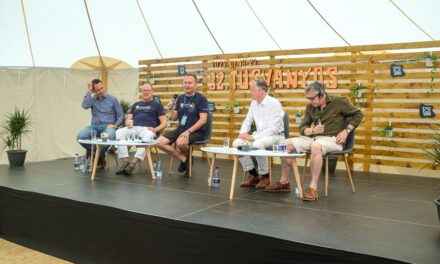If Népirtás Pozsonyligetfalun is included in one of the film festivals, they will already file a complaint, writes the producer.
They want to ban one of my films again - Fruzsina Skrabski her Facebook post As it turned out, some Slovak historians started writing to the organizers of film festivals where Skrabski's film Genocide in Bratislava will be selected.
"At first we were just surprised that there was a festival where our film was in competition, then they wrote that we were out of the competition.
We won the main prize elsewhere, such as Edufest, who wrote that Slovak "historians" (they put it in quotation marks) wrote to them that we were falsifying history. Fortunately, they haven't taken away our prize because of this, " writes the filmmaker.
"The nice team, which is trying to obstruct historical justice in this way, looks at my Facebook and if I point out that the film is in competition somewhere, they already write the complaint," reports Skrabski .
"I would like to ask them to write to me and sit down with the historians and discuss it, because I, as a producer, can only guarantee that the film will be based on real research results, the view of history is different for every country, we have to be able to live with it ! " - the producer told his whistleblowers.
Slovak pressure exercise for the Hungarian Motion Picture Festival
Pressure was exerted diplomatically on the part of Slovakia after the Hungarian Motion Picture Festival selected the work "Genocide in Pozsonyligetfalun" as one of the films nominated for the award - according to the post of the producer Fruzsina Skrabski. The film was directed by Dávid Géczy and Zoltán Udvardy, employees and editors of hirado.hu.
In the summer of 1945, the fate of Hungarian and German residents who were dragged to Ligetfalu, near Bratislava, which was turned into an internment camp, is revealed in the documentary entitled Genocide in Bratislava's Forest Village, which - according to hirado.hu. already reported – -jury delegated by the Hungarian Film Academy Association selected the five works nominated for the Hungarian Motion Picture Award
The film will be shown on June 23-26, 2021. between Veszprém, Balatonfüred and Balatonalmádi at the Hungarian Motion Picture Festival.
This documentary was selected for its program by the Ogeechee International History Film Festival in Georgia, held on February 26-27, 2021 in the United States. The film won first place in the Best Documentary Film Category at the EduFilm Festival in Slovakia in February 2021.
Fruzsina Skrabski, the producer of the film, indicated in her Facebook post that a group of "so-called historians", according to the wording of a hitherto unknown jury that awarded the film in Slovakia, previously in Slovakia, and now also in Hungary, is exerting pressure so that the film is not awarded. Now, before the upcoming screening at the Hungarian Motion Picture Festival - as the producer puts it - "they wrote not to show it! - but of course not in his own name, but through diplomacy."
The work not only deals with the massacre of Hungarian and German civilians returning home to the Highlands on a railway train, but also in Přerov, located in the Czech Republic, at the so-called Swedish Walls. (There were also 74 children among the victims here.) The circle of perpetrators is the same: both massacres were committed by the Czechoslovak infantry regiment No. 17, which was tasked with guarding the Pozsonyligetfalu internment camp. Both mass murders took place in the summer of 1945, just over a month apart.
Both the officers and the perpetrators were of Slovak nationality .
What happened divided the Slovak intelligentsia: an article supporting the film's claims appeared in the Slovak-language press, and after the film was shown, the work was sharply attacked several times by one of the Slovak electronic newspapers.
Frantysek Hybl, who found the executed
In the Czech Republic, the memory of German and Hungarian civilians massacred by Slovak soldiers (whose remains of women and children were cremated in a crematorium and hidden in the Olmütz cemetery two years after the liming in 1947 in order to eliminate the traces) was searched for by the Czech historian Frantysek Hybl, who reached , so that today there are memorials in both the Přerov and Olmütz cemeteries and in Přerov, at the so-called Swedish Walls.
Based on Hybl's research, it was possible to find the bodies of German and Hungarian highlanders executed in 1945 at the Swedish Ramparts in the Přerov and Olmütz cemeteries. The Czech historian also achieved that the boxes containing the ashes of the women and children hidden in Olmütz were dug out and reburied in a solemn mourning ceremony at the mass grave of the male family members of the executed, in the Přerov cemetery, "uniting" the families with a tragic fate in their deaths.
At the Swedish ramparts, as a result of Hybl's tireless work, today a monument: a huge cross stands on the site of the former mass murder.
As it is said in the film Genocide in Bratislava: this confrontation with the past has not yet happened in Slovakia.
The film can be viewed here:
Cover image: Excerpt from the film













